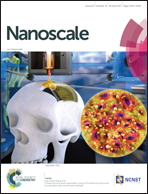3D-printable, highly conductive hybrid composites employing chemically-reinforced, complex dimensional fillers and thermoplastic triblock copolymers†
Abstract
The use of 3-dimensional (3D) printable conductive materials has gained significant attention for various applications because of their ability to form unconventional geometrical architectures that cannot be realized with traditional 2-dimensional printing techniques. To resolve the major requisites in printed electrodes for practical applications (including high conductivity, 3D printability, excellent adhesion, and low-temperature processability), we have designed a chemically-reinforced multi-dimensional filler system comprising amine-functionalized carbon nanotubes, carboxyl-terminated silver nanoparticles, and Ag flakes, with the incorporation of a thermoplastic polystyrene–polyisoprene–polystyrene (SIS) triblock copolymer. It is demonstrated that both high conductivity, 22 939 S cm−1, and low-temperature processability, below 80 °C, are achievable with the introduction of chemically anchored carbon-to-metal hybrids and suggested that the highly viscous composite fluids employing the characteristic thermoplastic polymer are readily available for the fabrication of various unconventional electrode structures by a simple dispensing technique. The practical applicability of the 3D-printable highly conductive composite paste is confirmed with the successful fabrication of wireless power transmission modules on substrates with extremely uneven surface morphologies.



 Please wait while we load your content...
Please wait while we load your content...